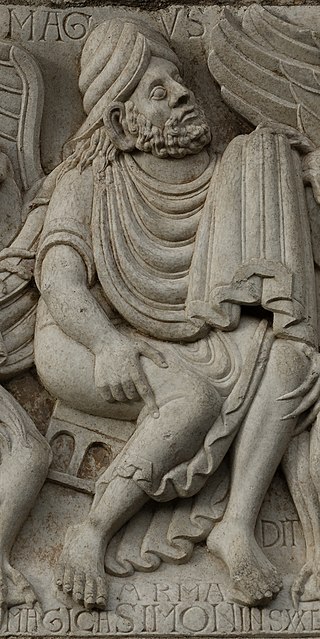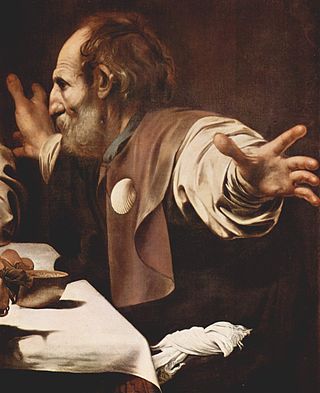Related Research Articles

Matthew the Apostle is named in the New Testament as one of the twelve apostles of Jesus. According to Christian traditions, he was also one of the four Evangelists as author of the Gospel of Matthew, and thus is also known as Matthew the Evangelist.

Simon Magus, also known as Simon the Sorcerer or Simon the Magician, was a religious figure whose confrontation with Peter is recorded in the Acts of the Apostles. The act of simony, or paying for position, is named after Simon, who tried to buy his way into the power of the Apostles.

Ebionites as a term refers to a Jewish Christian sect, which viewed poverty as a blessing, that existed during the early centuries of the Common Era. The Ebionites embraced an adoptionist Christology, thus understanding Jesus of Nazareth as a mere man who, by virtue of his righteousness in following the Law of Moses, was chosen by God to be the messianic "prophet like Moses". A majority of the Ebionites rejected as heresies the orthodox Christian beliefs in Jesus' divinity, virgin birth and substitutionary atonement; and therefore maintained that Jesus was born the natural son of Joseph and Mary, sought to abolish animal sacrifices by prophetic proclamation, and died as a martyr in order to move all Israel to repentance.

Epiphanius of Salamis was the bishop of Salamis, Cyprus, at the end of the 4th century. He is considered a saint and a Church Father by both the Eastern Orthodox and Catholic Churches. He gained a reputation as a strong defender of orthodoxy. He is best known for composing the Panarion, a compendium of eighty heresies, which included also pagan religions and philosophical systems. There has been much controversy over how many of the quotations attributed to him by the Byzantine Iconoclasts were actually by him. Regardless of this he was clearly strongly against some contemporary uses of images in the church.

James the Just, or a variation of James, brother of the Lord, was "a brother of Jesus", according to the New Testament. He was the first leader of the Jerusalem Church of the Apostolic Age. Traditionally, it is believed he was martyred in AD 62 or 69 by being stoned to death by the Pharisees on order of High Priest Ananus ben Ananus. James, Joses, Simon, and Judas are mentioned as the brothers or siblings of Jesus as well as two unnamed sisters.

The brothers of Jesus or the adelphoi are named in the New Testament as James, Joses, Simon, Jude, and unnamed sisters are mentioned in Mark and Matthew. They may have been: (1) the sons of Mary, the mother of Jesus, and Joseph, (2) sons of Mary the wife of Cleophas and sister of Mary, the mother of Jesus; or (3) sons of Joseph by a former marriage. While option 1 is described as the "most natural inference" from the New Testament, those who uphold the perpetual virginity of Mary reject the idea of biological brethren and maintain that the brothers and sisters were either cousins of Jesus or children of Joseph from a previous marriage. The Lutheran Churches have accepted both option 2 and option 3 as being valid explanations for the doctrine of the perpetual virginity of Mary.
Valentinus was the best known and, for a time, most successful early Christian Gnostic theologian. He founded his school in Rome. According to Tertullian, Valentinus was a candidate for bishop but started his own group when another was chosen.

Cleopas, also spelled Cleophas, was a figure of early Christianity, one of the two disciples who encountered Jesus during the Road to Emmaus appearance in Luke 24:13–32.
Clementine literature is the name given to the religious romance or "novel" which purports to contain a record made by one Clement of discourses involving the Apostle Peter, together with an account of the circumstances under which Clement came to be Peter's travelling companion, and of other details of Clement's family history. The author is sometimes called Pseudo-Clement.

The New Testament apocrypha are a number of writings by early Christians that give accounts of Jesus and his teachings, the nature of God, or the teachings of his apostles and of their lives. Some of these writings were cited as scripture by early Christians, but since the fifth century a widespread consensus has emerged limiting the New Testament to the 27 books of the modern canon. Roman Catholic, Eastern Orthodox, and Protestant churches generally do not view the New Testament apocrypha as part of the Bible.

The Gospel of the Ebionites is the conventional name given by scholars to an apocryphal gospel extant only as seven brief quotations in a heresiology known as the Panarion, by Epiphanius of Salamis; he misidentified it as the "Hebrew" gospel, believing it to be a truncated and modified version of the Gospel of Matthew. The quotations were embedded in a polemic to point out inconsistencies in the beliefs and practices of a Jewish Christian sect known as the Ebionites relative to Nicene orthodoxy.

The seventy disciples or seventy-two disciples, known in the Eastern Christian traditions as the seventy apostles or seventy-twoapostles, were early emissaries of Jesus mentioned in the Gospel of Luke. The correct Greek terminology is evdomikonta (ἑβδομήκοντα) apostoli or evdomikonta mathetes.
Dositheos was a Samaritan religious leader. He was the founder of a Samaritan sect often assumed to be Gnostic in nature, and is reputed to have known John the Baptist, and been either a teacher or a rival of Simon Magus.

Philastrius Bishop of Brescia, was one of the bishops present at a synod held in Aquileia in 381. Augustine of Hippo met him at Milan about 383, or perhaps a little later. He composed a catalogue of heresies about 384. He died before 397.
Pseudo-Abdias is the name formerly given to a collection of New Testament Apocrypha held by the Bibliothèque nationale de France and consisting of Latin translations in ten books containing several chapters. Each book describes the life of one of the Apostles.

The Jewish–Christian Gospels were gospels of a Jewish Christian character quoted by Clement of Alexandria, Origen, Eusebius, Epiphanius, Jerome and probably Didymus the Blind. All five call the gospel they know the "Gospel of the Hebrews", but most modern scholars have concluded that the five early church historians are not quoting the same work. As none of the works survive to this day attempts have been made to reconstruct them from the references in the Church Fathers. The majority of scholars believe that there existed one gospel in Aramaic/Hebrew and at least two in Greek, although a minority argue that there were only two, in Aramaic/Hebrew and in Greek.

In Christian theology and ecclesiology, the apostles, particularly the Twelve Apostles, were the primary disciples of Jesus according to the New Testament. During the life and ministry of Jesus in the 1st century AD, the apostles were his closest followers and became the primary teachers of the gospel message of Jesus. There is also an Eastern Christian tradition derived from the Gospel of Luke of there having been as many as seventy apostles during the time of Jesus' ministry.
Pseudo-Linus is the name given to the author of a fourth-century account of the martyrdom of Paul, the "Passio Sancti Pauli Apostoli".
The Gospel of the Twelve Apostles is a gospel text that summarizes the four canonical gospels and the beginning of the Acts of the Apostles followed by three apocalypses. It survives only in a single manuscript and is inspired by the Apocalypse of Pseudo-Methodius. Its eschatological expectations was both simple and updated from previous Syriac apocalyptical texts of the same period and is a witness to the Syrian Christian strategy on coping with Muslim rule in the second half of the seventh century as the Muslim rule was no longer being perceived as a temporary event causing apocalyptic tensions to dissipate. It also advocates disconnection from Judaism and non-Miaphysite and presents the author's advocacy in their own community to not have them convert to Islam but have the community keep the true faith.
References
- ↑ Enrico Mazza (1995). The Origins of Eucharistic Prayer. Liturgical Press. pp. 119–. ISBN 978-0-8146-6119-2 . Retrieved 13 November 2012.
- ↑ Robert V. Hotchkiss (1974). A Pseudo-Epiphanius testimony book. Society of Biblical Literature. ISBN 9780884140436 . Retrieved 13 November 2012.
- ↑ Peter Megill Peterson (1958). Andrew, Brother of Simon Peter. Brill Archive. pp. 18–. GGKEY:NDAX1JCBZUT. Retrieved 13 November 2012. "Pseudo-Epiphanios, as he is now called, was the first to introduce into the stories about Andrew or the Twelve the statement that he appointed Stachys the first bishop for Byzantium. His reference to an older tradition is primarily to the Acts and "